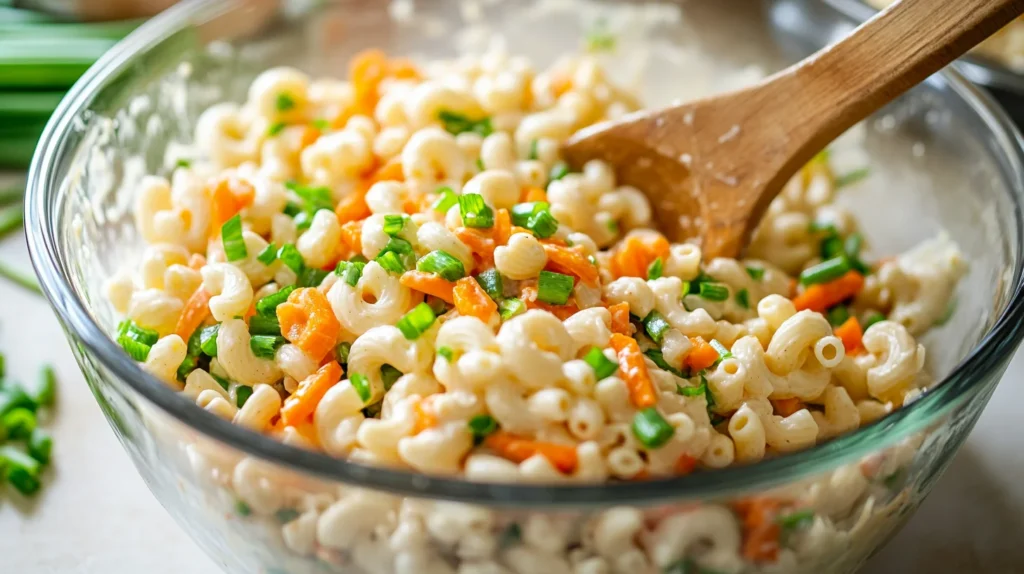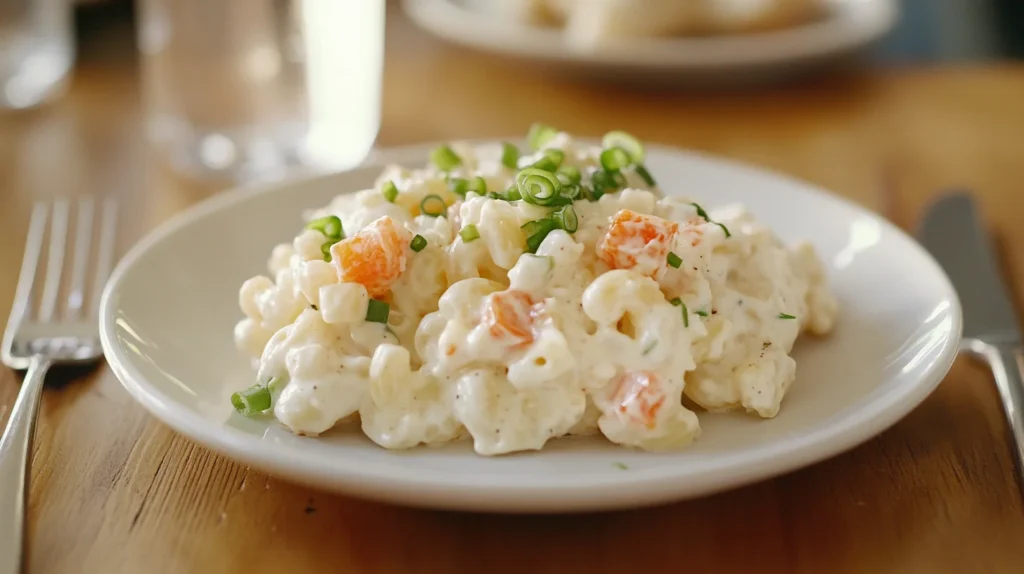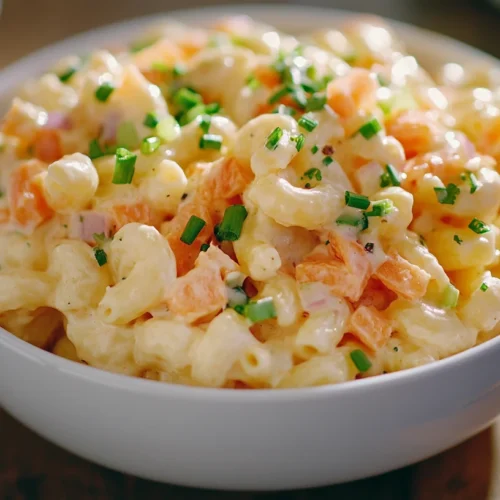Hawaiian macaroni salad is a beloved dish with a rich cultural history and mouthwatering taste. This creamy, tangy, and slightly sweet salad is a cornerstone of Hawaiian cuisine, often served alongside grilled meats, rice, and traditional dishes in the iconic plate lunch. Its simple yet flavorful preparation makes it a crowd-pleaser at barbecues, luaus, and family gatherings.
The dish’s appeal lies in its perfect balance of soft macaroni, creamy mayonnaise, and the crunch of fresh vegetables, all enhanced by a unique touch of Hawaiian flair. Whether you’re looking to explore Hawaiian food culture or simply want to elevate your salad game, Hawaiian macaroni salad is a must-try.

The Origins of Hawaiian Macaroni Salad
History of Hawaiian Cuisine
Hawaiian cuisine is a reflection of the islands’ rich history and cultural diversity, shaped by Polynesian traditions, immigrant influences, and local ingredients. From the first Polynesian settlers to waves of immigrants from Japan, China, Portugal, and the Philippines, each group brought its culinary traditions, resulting in a fusion of flavors that defines Hawaiian food today.
Influence of Different Cultures
Macaroni salad came to Hawaii with Western influences in the 19th century, especially with the use of mayonnaise and pasta. These ingredients became popular because they were cheap and lasted a long time. Over the years, local cooks changed the salad to fit Hawaiian tastes, making it sweeter and creamier to go with traditional meals.
Macaroni Salad’s Unique Role in Hawaiian Plate Lunches
A Hawaiian plate lunch is incomplete without macaroni salad. Served alongside sticky rice and a protein like kalua pork, chicken katsu, or teriyaki beef, this side dish balances the meal with its creamy and tangy profile. It has become a symbol of Hawaiian comfort food, loved by locals and visitors alike.
Key Ingredients for Hawaiian Macaroni Salad
The Role of Macaroni Pasta
Elbow macaroni is the cornerstone of this dish. Its small size and tubular shape make it ideal for soaking up the creamy dressing. Overcooking the pasta slightly (beyond al dente) is key to achieving the signature soft texture that distinguishes Hawaiian macaroni salad from other variations.
The Importance of Mayonnaise
Mayonnaise is the heart of the dressing, providing the creamy base that binds the ingredients together. In authentic Hawaiian macaroni salad, full-fat mayonnaise is typically used for its rich flavor and smooth texture. Some versions also include a splash of milk to create an even silkier consistency.
Vegetables: Carrots, Celery, Onions, and Others
Fresh vegetables add crunch and balance to the dish. Grated carrots are a must-have, offering sweetness and a pop of color. Celery and onions provide a subtle crunch and flavor contrast, while green onions or parsley can be added for garnish. Each ingredient is finely chopped to ensure a cohesive texture.
Optional Additions Like Pineapple or Tuna
While traditional recipes keep it simple, some variations incorporate additional ingredients for a unique twist. Crushed pineapple adds a tropical sweetness, while canned tuna or shredded chicken can transform it into a heartier side dish. Raisins, peas, or sweet relish may also be included, depending on personal preference.
Crafting the Perfect Hawaiian Macaroni Salad

Choosing the Right Macaroni Type
Selecting the right type of macaroni is the foundation of a great Hawaiian macaroni salad. Elbow macaroni is the traditional choice, but the texture is just as crucial as the shape. Overcooking the pasta slightly ensures it becomes soft enough to absorb the dressing, creating a melt-in-your-mouth experience. Avoid using gluten-free or alternative pastas unless adapting for dietary needs, as they may not replicate the desired consistency.
Step-by-Step Preparation Guide
- Cook the Pasta: Boil elbow macaroni in salted water, overcooking slightly for extra softness. Drain and rinse with cold water to stop the cooking process.
- Prepare the Dressing: In a mixing bowl, combine mayonnaise, milk, a splash of apple cider vinegar, and a pinch of sugar. Whisk until smooth.
- Incorporate the Vegetables: Grate carrots and finely chop onions and celery. Stir them into the dressing to evenly distribute flavors.
- Combine Ingredients: Fold the cooled macaroni into the dressing, ensuring every piece is thoroughly coated. Adjust seasoning with salt and pepper.
- Let It Chill: Refrigerate the salad for at least 2 hours to allow the flavors to meld. Serve cold.
Tips for Achieving Creamy Texture
- Use full-fat mayonnaise for the best results. Low-fat versions may compromise flavor and consistency.
- Add a splash of milk to the dressing if it feels too thick, ensuring a smooth coating.
- Stir the salad just before serving to redistribute the dressing evenly.
Balancing Flavors: Sweet, Tangy, and Savory
Hawaiian macaroni salad achieves its unique flavor by balancing key elements. A touch of sugar and apple cider vinegar provides the signature sweet-tangy note, while salt and pepper bring out the savory aspects. Experiment with quantities to suit your taste preferences, keeping the overall flavor harmonious.
Variations of Hawaiian Macaroni Salad
Classic Hawaiian Macaroni Salad
Stick to the basics with elbow macaroni, mayonnaise, milk, grated carrots, and finely chopped onions. This minimalist version celebrates the traditional flavors that make Hawaiian macaroni salad iconic.
Healthy Variations with Yogurt
For a healthier choice, swap some or all of the mayonnaise with plain Greek yogurt. This reduces fat but keeps it creamy. Add lemon juice for a tangy flavor.
Vegan and Gluten-Free Adaptations
For a vegan option, use vegan mayo and plant-based milk like almond or soy. For gluten-free, swap regular pasta with gluten-free macaroni or quinoa pasta, but the texture may be slightly different.
Gourmet Twists for a Unique Taste
Elevate your Hawaiian macaroni salad with gourmet ingredients:
- Add Protein: Toss in shredded rotisserie chicken, shrimp, or diced ham for a more substantial dish.
- Incorporate Herbs: Fresh dill, parsley, or cilantro can add an herbaceous note.
- Flavor Enhancers: Sprinkle in smoked paprika, garlic powder, or a drizzle of sesame oil for a creative spin.
Pairing Hawaiian Macaroni Salad with Other Dishes
Popular Pairings in Hawaiian Cuisine
Hawaiian macaroni salad shines as a side dish in a traditional Hawaiian plate lunch. It perfectly complements two scoops of white rice and a protein-rich main course like:
- Kalua Pork: The smoky, tender flavors of this slow-cooked pork are balanced by the creamy and tangy macaroni salad.
- Chicken Katsu: The crunchy breading of fried chicken katsu pairs wonderfully with the salad’s smooth texture.
- Teriyaki Beef: The sweet and savory glaze of teriyaki beef enhances the subtle sweetness of the salad.
Complementing Barbecues and Luau Feasts
At luaus or backyard barbecues, Hawaiian macaroni salad is a star attraction. It pairs effortlessly with grilled dishes like:
- Huli Huli Chicken: The caramelized pineapple glaze of huli huli chicken is offset by the creamy macaroni.
- Grilled Fish: Lightly seasoned mahi-mahi or ahi tuna complements the richness of the salad.
- Ribs or Pulled Pork: Whether sweet or spicy, the tender meat and tangy barbecue sauce are enhanced by the cool, creamy flavors of the salad.
Serving with Seafood, Pork, or Chicken
Hawaiian macaroni salad is a flexible dish that makes any meal better with its comforting, homemade feel. For a lighter choice, pair it with grilled chicken or seafood. For a heavier meal, serve it with pork chops or a Hawaiian hamburger steak.
Tips for Serving and Storing Hawaiian Macaroni Salad

Ideal Serving Temperature
Hawaiian macaroni salad tastes best when served cold. Chill it in the fridge for at least two hours before serving so the flavors mix well. If you’re serving it outside, keep it in a cooler or on ice to stay fresh.
How to Store Leftovers
To store leftovers:
- Refrigerate Promptly: Transfer the salad into an airtight container and refrigerate within two hours of serving.
- Shelf Life: The salad remains fresh for up to 3-4 days in the refrigerator.
- Avoid Freezing: Freezing can cause the mayonnaise to separate and alter the texture of the salad.
Preventing Sogginess and Flavor Loss
- Rinse the Pasta Thoroughly: After cooking, rinse the macaroni in cold water to remove excess starch, which can lead to a gummy texture.
- Drain Well: Ensure the pasta is completely dry before mixing it with the dressing to prevent excess moisture.
- Replenish Dressing: If the salad becomes dry after refrigeration, refresh it with an extra dollop of mayonnaise or a splash of milk before serving.
The Cultural Significance of Hawaiian Macaroni Salad
Its Place in Hawaiian Celebrations
Hawaiian macaroni salad is more than a side dish—it’s a beloved part of the islands’ food culture. At luaus, family meals, and community events, this creamy salad is always a favorite. It shows Hawaii’s spirit of hospitality and sharing, with its simple recipe loved by all.
A Symbol of Multicultural Fusion
Hawaiian macaroni salad comes from a mix of cultures. It combines simple Western ingredients like pasta and mayonnaise with the unique tastes of the islands. This mix of food traditions reflects Hawaii’s rich history and the blending of global influences in its cooking.
How It Represents Hawaiian Comfort Food
Like loco moco or spam musubi, macaroni salad is a classic comfort food in Hawaii. Its creamy texture and tangy taste bring back fond memories for locals. It’s a simple but important part of the plate lunch, loved for making everyday meals feel special.
Health Benefits and Nutritional Profile
Caloric Breakdown and Ingredients
Hawaiian macaroni salad is indulgent, but understanding its nutritional profile can help you enjoy it in moderation:
- Calories: One cup typically contains 300–400 calories, depending on the ingredients and portion of mayonnaise used.
- Carbohydrates: Pasta contributes to the bulk of the carbs, making this a high-energy side dish.
- Fats: Mayonnaise is a significant source of fat, offering creaminess and flavor.
How to Make It Healthier Without Losing Flavor
For those seeking a lighter option:
- Swap Mayonnaise: Use light mayonnaise or a mix of Greek yogurt and low-fat mayo for reduced fat and calories.
- Incorporate Whole Grains: Substitute traditional elbow macaroni with whole-grain or chickpea pasta for added fiber and protein.
- Increase Vegetables: Add more grated carrots, celery, or peas to boost the fiber and nutrient content without significantly increasing calories.
Benefits of Homemade Preparation
Making Hawaiian macaroni salad at home lets you choose the ingredients, portions, and nutrition. This way, you can make a healthier version without losing the delicious flavors
- Crab Salad Variations: For seafood lovers, this crab salad recipe offers a fresh and healthy pairing.
- Easy Breakfast Pizza: A delightful twist on pizza, perfect for serving at brunches with a side of Hawaiian macaroni salad.
- Fresh Burrata Salad: Elevate your salad game with creamy burrata—a refreshing addition to your summer table.
Frequently Asked Questions
Why Is Macaroni Salad So Popular in Hawaii?
Macaroni salad is very popular in Hawaii because it is simple, affordable, and easy to make. It pairs perfectly with the strong flavors of Hawaiian food. It’s a key part of the Hawaiian plate lunch, where its creamy and tangy taste balances savory dishes like kalua pork or teriyaki beef. The salad also shows Hawaii’s rich mix of cultures, combining Western ingredients like pasta and mayonnaise with the local love for sweet and tangy flavors. Its easy preparation and availability make it a top choice for parties, luaus, and barbecues.
What Is the Difference Between Hawaiian Mac Salad and Regular Mac Salad?
Hawaiian macaroni salad differs from regular macaroni salad in several key ways:
- Texture: Hawaiian mac salad uses slightly overcooked pasta, which gives it a softer, creamier texture, unlike the firmer pasta in traditional recipes.
- Flavor Profile: Hawaiian mac salad emphasizes a sweeter and tangier flavor, often incorporating sugar, apple cider vinegar, or pineapple juice. Regular mac salad may include more savory elements like mustard or pickle relish.
- Simplicity: Hawaiian mac salad typically has a minimalist ingredient list—macaroni, mayonnaise, milk, and a few vegetables—whereas regular mac salad might feature a wider variety of ingredients like eggs, cheese, or meats.
- Serving Style: Hawaiian mac salad is traditionally served cold as a side dish in plate lunches, while regular mac salad is more versatile in its uses.
What Are the Five Mistakes to Avoid in Pasta Salad?
- Overcooking or Undercooking Pasta: For pasta salad, especially Hawaiian macaroni salad, slightly overcooking the pasta is key to achieving a creamy texture. Avoid undercooking as it can lead to a tough and chewy salad.
- Not Cooling Pasta Properly: Hot pasta can cause the dressing to separate or lose its intended texture. Always cool the pasta thoroughly before mixing it with the dressing.
- Skipping Seasoning: Failing to season the pasta water or the salad itself can result in a bland dish. Be generous with salt during boiling and adjust flavors in the dressing.
- Using Too Much or Too Little Dressing: Overdressing can make the salad heavy and greasy, while underdressing leaves it dry and flavorless. Add the dressing gradually and mix well to coat evenly.
- Neglecting Flavor Balance: A great pasta salad has a balance of sweet, tangy, and savory flavors. Overloading one element, like vinegar or sugar, can throw off the balance. Always taste-test as you go.
What Culture Is Macaroni Salad From?
Macaroni salad comes from Western cuisine, especially in the United States, where pasta salads became common in the 1800s and 1900s. It grew popular because pasta and mayonnaise were cheap and easy to store. In Hawaii, people changed the recipe to match local flavors, creating a dish that reflects the mix of cultures on the islands. Immigrants from Asia, Europe, and Polynesia all helped shape the Hawaiian version of macaroni salad.
Conclusion
Hawaiian macaroni salad is more than a side dish—it’s a symbol of Hawaii’s unique food culture. Its creamy, tangy, and slightly sweet taste makes it a perfect match for many meals, from plate lunches to barbecues.
Whether you follow the classic recipe or try new twists, Hawaiian macaroni salad is a crowd-pleaser that brings people together. Making it at home lets you enjoy a piece of Hawaiian comfort food while tailoring it to your tastes and needs

Authentic Hawaiian Macaroni Salad – Creamy, Tangy, and Easy to Make
Equipment
- Large mixing bowl
- Whisk for dressing
- Cutting board
- Sharp knife
- Large pot (for boiling pasta)
- Colander (for draining pasta)
- Wooden spoon (for mixing)
Ingredients
- ✅ For the Salad:
- 2 cups elbow macaroni
- 1 medium carrot shredded
- ¼ cup red onion finely diced
- 2 tablespoons green onions chopped (for garnish)
- ✅ For the Creamy Dressing:
- 1 cup mayonnaise preferably Best Foods or Hellmann’s
- ¼ cup whole milk
- 1 tablespoon apple cider vinegar
- 1 teaspoon sugar
- ½ teaspoon salt
- ¼ teaspoon black pepper
Instructions
- 🔸 Step 1: Cook the Macaroni
- 1️⃣ Bring a large pot of salted water to a boil. Add elbow macaroni and cook until very soft, about 1–2 minutes past al dente (this helps the pasta absorb the dressing).
- 2️⃣ Drain the pasta and rinse with cold water to cool it down slightly.
- 3️⃣ Transfer to a mixing bowl and let it cool completely at room temperature.
- 🔸 Step 2: Make the Dressing
- 4️⃣ In a small bowl, whisk together mayonnaise, milk, apple cider vinegar, sugar, salt, and black pepper until smooth.
- 🔸 Step 3: Assemble the Salad
- 5️⃣ Add the shredded carrots and diced red onions to the cooled pasta.
- 6️⃣ Pour the creamy dressing over the pasta and mix gently until fully coated.
- 🔸 Step 4: Chill & Serve
- 7️⃣ Cover and refrigerate for at least 1 hour (or overnight) to let the flavors develop.
- 8️⃣ Before serving, stir the salad and sprinkle with chopped green onions for extra flavor. Enjoy chilled!
Notes
Let It Rest: The salad tastes best after chilling for a few hours, as the pasta absorbs the flavors.
For Extra Creaminess: Stir in an additional ¼ cup of mayo before serving.
Add More Texture: Some variations include chopped celery, hard-boiled eggs, or sweet relish.

